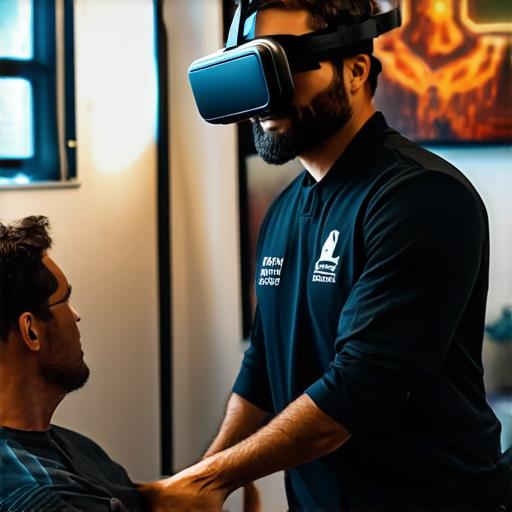Virtual reality (VR) technology has been gaining traction in recent years due to its potential applications in various fields. One such application is virtual reality exposure therapy, which involves using VR simulations to expose individuals to situations or environments that they may find difficult or traumatic in real life.
1. Understanding Virtual Reality Exposure Therapy
Virtual reality exposure therapy (VRET) is a type of therapy that uses VR simulations to expose patients to situations or environments that trigger their anxiety, fear, or other negative emotions. This form of therapy has been shown to be effective in treating a range of mental health conditions, including post-traumatic stress disorder (PTSD), phobias, and anxiety disorders.
2. How Virtual Reality Exposure Therapy Works
-
Initial Assessment: The first step in VRET is to conduct an initial assessment of the patient’s mental health condition and determine the most appropriate VR simulations for their treatment plan. This may involve a series of interviews, questionnaires, and other assessments to identify the triggers that are causing the patient’s symptoms.
-
Virtual Reality Simulations: Once the appropriate VR simulations have been identified, patients undergo therapy sessions in which they are exposed to these simulations while wearing a VR headset. The simulations are designed to mimic real-life situations or environments that trigger the patient’s anxiety or fear.
-
Feedback and Support: During each therapy session, the therapist provides feedback and support to the patient as they navigate the VR simulation. This may include cognitive restructuring techniques, relaxation exercises, and other interventions designed to help patients learn coping strategies and manage their emotions.
-
Exposure Dose: The exposure dose in VRET refers to the amount of time that a patient spends in a VR simulation. The exposure dose is gradually increased over time as the patient becomes more accustomed to the virtual environment. This process helps patients develop tolerance and resilience to situations or environments that may have previously triggered their anxiety or fear.
-
Maintenance: Once therapy sessions have ended, patients continue to work on maintaining their progress through ongoing support and follow-up care. This may include individual therapy sessions, group therapy, or self-help resources designed to help them maintain their gains.
3. The Science Behind Virtual Reality Exposure Therapy
Virtual reality exposure therapy is based on several principles of cognitive behavioral therapy (CBT) and other evidence-based therapies. These include:
-
Classical Conditioning: VRET relies on the principles of classical conditioning to help patients learn to associate positive responses with virtual environments that were previously associated with negative emotions.
-
Exposure Therapy: VRET is based on the principles of exposure therapy, which involves gradually exposing individuals to situations or environments that trigger their anxiety or fear until they become accustomed to them.
-
Cognitive Restructuring: VRET includes cognitive restructuring techniques designed to help patients challenge negative thoughts and beliefs that are contributing to their mental health condition.
-
Relaxation Techniques: VRET includes relaxation techniques such as deep breathing, progressive muscle relaxation, and mindfulness meditation to help patients manage their emotions in a safe and controlled environment.
4. Case Studies and Real-Life Examples of Virtual Reality Exposure Therapy
Virtual reality exposure therapy has been used successfully to treat a range of mental health conditions. Here are a few examples:
-
PTSD: A study published in the Journal of Traumatic Stress found that virtual reality exposure therapy was effective in reducing symptoms of PTSD in veterans who had experienced combat-related trauma. The study found that participants who underwent VRET reported significant reductions in symptoms of re-experiencing, avoidance, and arousal compared to participants who received traditional cognitive behavioral therapy (CBT).
-
Phobias: A study published in the Journal of Anxiety Disorders found that virtual reality exposure therapy was effective in reducing symptoms of social anxiety disorder in individuals with social phobia. The study found that participants who underwent VRET reported significant reductions in anxiety and avoidance compared to participants who received traditional CBT or a placebo treatment.
-
Generalized Anxiety Disorder: A study published in the Journal of Consulting and Clinical Psychology found that virtual reality exposure therapy was effective in reducing symptoms of generalized anxiety disorder (GAD) in individuals with GAD. The study found that participants who underwent VRET reported significant reductions in anxiety and worry compared to participants who received traditional CBT or a placebo treatment.
5. Expert Opinions on Virtual Reality Exposure Therapy

Virtual reality exposure therapy has been endorsed by several professional organizations, including the American Psychological Association (APA) and the British Association for Counselling and Psychotherapy (BACP). The APA has issued a practice guideline on the use of VRET in treating PTSD, which recommends that VRET be used in combination with other evidence-based treatments. The BACP has also endorsed VRET as an effective treatment for a range of mental health conditions, including anxiety disorders and PTSD.
6. FAQs on Virtual Reality Exposure Therapy
Q: Is virtual reality exposure therapy safe?
A: Yes, virtual reality exposure therapy is generally considered safe when conducted by qualified therapists in a controlled environment. However, as with any form of treatment, there are potential risks and side effects that should be discussed with the therapist before beginning therapy sessions.
Q: How effective is virtual reality exposure therapy?
A: Virtual reality exposure therapy has been shown to be effective in treating a range of mental health conditions, including PTSD, phobias, and anxiety disorders. Studies have found that VRET can be as effective as traditional cognitive behavioral therapy (CBT) or other evidence-based treatments.
Q: Who is virtual reality exposure therapy appropriate for?
A: Virtual reality exposure therapy is appropriate for individuals who are struggling with a range of mental health conditions, including PTSD, phobias, and anxiety disorders. It can also be used as an adjunct treatment in combination with other evidence-based treatments.
Q: What are the risks and side effects of virtual reality exposure therapy?
A: The risks and side effects of virtual reality exposure therapy are generally mild and may include nausea, dizziness, and headaches. However, these symptoms typically resolve quickly and do not require medical attention.
7. Summary
Virtual reality exposure therapy is a promising treatment for a range of mental health conditions. It relies on several principles of cognitive behavioral therapy (CBT) and other evidence-based therapies to help individuals learn to manage their emotions and cope with difficult situations or environments. Virtual reality exposure therapy has been shown to be effective in reducing symptoms of PTSD, phobias, and anxiety disorders, and it is endorsed by several professional organizations as an effective treatment option. If you are struggling with a mental health condition and are considering virtual reality exposure therapy, it is important to speak with a qualified therapist before beginning treatment sessions.




